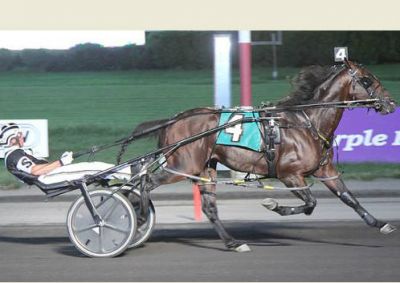On occasion, I get asked about how I come up with harness racing story ideas.
Sometimes, it’s a suggestion and, sometimes, I see something happen and, bingo, a light goes off in what’s left of my brain these days.
 That’s what happened this time around when our local mom-and-pop hardware store closed.
That’s what happened this time around when our local mom-and-pop hardware store closed.
When I first saw the “EVERYTHING MUST GO” sign, I asked the owner why he’s closing and he said, “I just can’t compete with the big boys in town anymore!”
Yes, competition is tough for the “little guy” these days…no matter the business…and that includes our sport, especially in the breeding industry.
Doctor Butch and Highalator quickly come to mind, two very rugged performers over the years and now, in the infancy of their individual careers passing their greatest traits onto their sons and daughters.
They both showed that they have the credentials to be great sires but one thing “stands” in their way—competition.
Doctor Butch, a son of Art Major, was a rugged performer on the track showing early speed—both in age and leaving the gate—with a two-year-old mark of 1:52f while compiling an 8-4-0 scorecard in 12 starts, earning $344,411. He lowered his mark every year through the age of five and had a million dollars plus on his resume by the time he was five with multiple sub-1:50 miles, including his 1:48.1 mark.

Described by David Miller as the “perfect looking Standardbred,” Doctor Butch was a multiple stakes winner, could handle any size track and was rugged enough to get to the gate 329 times (and still going) with 56 wins, many against top FFA competition.
So, what’s the problem?
The problem is—or problems are—Captaintreacherous, Sweet Lou, Downbytheseaside, Stay Hungry, Huntsville, American Ideal, Always B Miki and Lazarus N…just to name a few.
Captaintreacherous had 97 starters from 117 foals last season, and they won close to $4 million while Sweet Lou, Downbytheseaside, Stay Hungry and Huntsville had similar percentages of foals that got to the races last year.
The fact that he’s in Virginia, where the Stakes program is just getting started, is a positive for Doctor Butch and, thus far, with the program just “foaled,” there’s not too much competition and success there might be a bit easier not having to compete against two-year-old pacers going faster than 1:52.
Miller said Doctor Butch was a “gutsy, extremely durable horse and very handy—able to get around any size racetrack and they just have to get a talented broodmare to produce the one that can put him on the map.
“I know it’s a big hill to climb,” he said, “but it’s been done many, many times before and his success wouldn’t surprise me in the least.”
Owner Mike Annunziata likes the Virginia budding program with incentives for the Sires Stakes and the Breeders Series with very few eligibles at the outset—13 colts or geldings and 10 fillies.
Annunziata also lauded the breeders award saying “there’s an incentive for any registered foal that places in 2:11…yes, 2:11! And there’s a $400,000 fund in matching purse money that’s also to be allocated.
“It’s perfect for the small breeder like me to get started,” he said, “and I’m not about to think I can compete with the top guns.”
Highalator, a son of Somebeachsomewhere, has just moved from Indiana to Delaware with his first crop of 58 colts and fillies, hopefully, beginning their racing careers next year.

He’s the only SBSW in Delaware and his credentials on track are startling. With only two starts at two—one win—Highalator went on a terror the next three seasons against many of the top pacers in the land winning 31 times and taking a mark of 1:48—:26.2—at age four and putting an asterisk on that the next year—1:48f.
With 43 wins in 104 career starts, he regularly capped his miles in :26 and changed and, during one Big M performance, his 1:48.3 win was topped off with a :25.2 finale.
This isn’t an advertisement for these two…it’s just showing how difficult it is to break into the list of top breeders from Hanover Shoe Farms, whose performers won 2,372 races and over $35 million in purse money last season, and Winbak Farm whose starters won almost 2,000 races and over $20 million in 2022.
These two breeders, to their great credit, outpaced the combined total of the next 14 breeders on the “win” list and next 13 on the earnings list COMBINED!
By the way, number 50 on the “win” list had 84 wins. And where does that leave the breeder that is number 200 or 300 on the list?
One owner said, “Going start to finish from the sales ring to the racetrack is expensive and many of us don’t have the patience to see the process through to after the age of two or three. If a yearling is $200,000 or more—or even $30,000 or $50,000—add the daily training fees and vet work and we’re just hoping to get the one that has the ability, health and courage to make it big. We’re not looking for another Good Humor Man!
“The days of the 2:10 two-year-old are long gone (JB’s note: unless you’re in the Virginia program) and I’m not about to try and climb Mount Everest with a jacket and sneakers!”
But, as the late Hall of Fame breeder Bill Weaver once said, “once you’re bitten by the (harness racing) bug, it’s very hard not to chase the dream of owning a champion.”
Bill Weaver was living proof!
by John Berry, for Harnesslink

 USA
USA Canada
Canada Australia
Australia New Zealand
New Zealand Europe
Europe UK / IRE
UK / IRE



